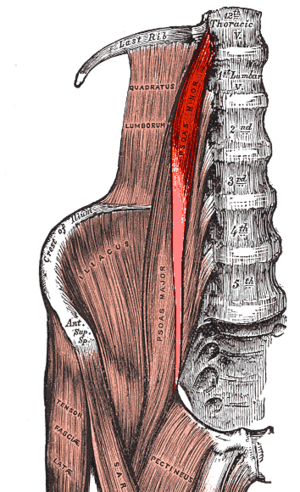Psoas Minor: Difference between revisions
Eman Ammar (talk | contribs) No edit summary |
Maram Salem (talk | contribs) (edited reference list) |
||
| (8 intermediate revisions by 3 users not shown) | |||
| Line 3: | Line 3: | ||
'''Lead Editors''' - {{Special:Contributors/{{FULLPAGENAME}}}} | '''Lead Editors''' - {{Special:Contributors/{{FULLPAGENAME}}}} | ||
</div> | </div> | ||
< | == Introduction == | ||
The psoas minor is a thin muscle in the posterior abdominopelvic region located in front of the [[Psoas_Major|psoas major]].<ref name="p1">Gray, Henry. Anatomy of the Human Body. Philadelphia: Lea & Febiger, 1918; Bartleby.com, 2000. www.bartleby.com/107/.</ref> It functions as part of the iliopsoas muscle complex, along with the psoas major and iliacus muscles. It is essential for correct standing or sitting [[Lumbar Examination|lumbar posture]], [[Hip Anatomy|hip joint]], and during [[Walking - Muscles Used|walking]] and [[Running Biomechanics|running]].<ref>Bordoni B, Varacallo M. [https://www.ncbi.nlm.nih.gov/books/NBK531508/ Anatomy, Bony Pelvis and Lower Limb, Iliopsoas Muscle.] StatPearls [Internet]. 2021 Jul 21. Available:https://www.ncbi.nlm.nih.gov/books/NBK531508/ (accessed 16.1.2022)</ref> It is only found in 40-60% of individuals and its function is considered to be extremely subtle.<ref name=":0">Guerra DR, Reis FP, de Andrade Bastos A, Brito JC, dos Santos Silva JR, Aragão AJ, GUERRA D, REIS F, BASTOS A, BRITO C, SILVA R. Anatomical study on the psoas minor muscle in human fetuses. Int J Morphol. 2012 Mar 1;30(1):136-9.</ref> There is limited research on the psoas minor muscle since its presence can vary between individuals. | |||
== Anatomy == | |||
[[Image:Musculus_psoas_minor.png|psoas minor|alt=|right|frameless]]'''Origin''' | |||
The psoas minor muscle originates along the lateral aspect of the vertebral body of the 12th thoracic vertebrae and the 1st lumbar vertebrae, and the intervertebral disc between those two vertebrae. There are two psoas minors, if present, one on each side of the spine. | |||
'''Insertion''' | |||
Distally, the psoas minor muscle blends with the iliopsoas fascia.<ref name=":0" />Various studies have concluded where the psoas minor inserts, such as pectin pubis, iliopubic eminence, arcuate line, pectineal line or iliopubic ramus.<ref>Pavlovsky E, Vinson J, Reynolds A, Lesciotto KM. Psoas Minor: Major Confusion. The FASEB Journal. 2022 May;36.</ref> | |||
'''Nerve Supply''' | |||
Innervation of the psoas minor comes from the ventral ramus of the L1 spinal nerve.<ref name=":1">Agichani S, Sontakke Y, Joshi SS, Joshi SD. Morphology of psoas minor muscle‐reviewed. J Evolution Med Dent Sci. 2013 Aug 5;2:5867-9.</ref> | |||
'''Blood''' | |||
Its main blood supply comes from the lumbar branch of the iliolumbar artery. The common iliac artery sends thin branches of blood supply to the psoas minor. | |||
== Function == | |||
Along with the iliacus and psoas major, the psoas minor muscle functions to flex the hip. It also assists with flexion of the lumbar vertebral column.<ref name=":1" /> | |||
== | == Physiotherapy == | ||
[[File:Baseball.jpeg|right|frameless]] | |||
Athletic injuries to the hip flexors (including psoas minor) have been described in populations across all levels of competitive sports. Estimates of hip flexor pathology ranges from 5% of injuries all the way to 28% of injuries among high-risk sport-specific groups. Although most of these injuries are successfully treated with conservative management and high rates of return to play are observed, significant rehabilitation time can be involved. Poor [[posture]], general [[Overuse Injuries in Sport|overuse]], and sometimes [[arthritis]] can also cause pain in the hip flexors.<ref>Physiopedia [[Hip Flexors]] Available:[[Hip Flexors]] (accessed 16.1.2022)</ref> | |||
Psoas minor syndrome is caused by a tense muscle and tendon and presents as chronic lower back pain.<ref>Dragieva P, Zaharieva M, Kozhuharov Y, Markov K, Stoyanov GS. Psoas minor muscle: a cadaveric morphometric study. Cureus. 2018 Apr 8;10(4).</ref> Symptoms of this syndrome include localized pain at the iliac fossa that is worsened with palpation. This syndrome can be mistakenly thought to be appendicitis if palpated on the right side.<ref>Anderson CN. Iliopsoas: pathology, diagnosis, and treatment. Clinics in sports medicine 2016;35(3):419-33. | |||
<ref | |||
Micheo W. Musculoskeletal, Sports and Occupational Medicine. Demos Medical Publishing; 2010 Dec 21. | |||
</ref> | |||
< | |||
== References == | == References == | ||
<references /> | <references /> | ||
[[Category:Muscles]] | [[Category:Muscles]] | ||
[[Category:Hip]] | [[Category:Hip]] | ||
[[Category:Thoracic Spine]] | [[Category:Thoracic Spine]] | ||
[[Category:Lumbar Spine]] | [[Category:Lumbar Spine]] | ||
[[Category:Hip - Anatomy]] | |||
[[Category:Lumbar Spine - Anatomy]] | |||
[[Category:Thoracic Spine - Anatomy]] | [[Category:Thoracic Spine - Anatomy]] | ||
[[Category:Thoracic Spine - Anatomy]] | [[Category:Thoracic Spine - Anatomy]] | ||
[[Category:Hip - Muscles]] | |||
[[Category:Lumbar Spine - Muscles]] | [[Category:Lumbar Spine - Muscles]] | ||
[[Category:Thoracic Spine - Muscles]] | [[Category:Thoracic Spine - Muscles]] | ||
[[Category:Thoracic Spine - Muscles]] | [[Category:Thoracic Spine - Muscles]] | ||
Latest revision as of 01:10, 1 April 2024
Original Editor - Oyemi Sillo
Lead Editors - Kim Jackson, Eman Ammar, Lucinda hampton, Maram Salem, WikiSysop and Oyemi Sillo
Introduction[edit | edit source]
The psoas minor is a thin muscle in the posterior abdominopelvic region located in front of the psoas major.[1] It functions as part of the iliopsoas muscle complex, along with the psoas major and iliacus muscles. It is essential for correct standing or sitting lumbar posture, hip joint, and during walking and running.[2] It is only found in 40-60% of individuals and its function is considered to be extremely subtle.[3] There is limited research on the psoas minor muscle since its presence can vary between individuals.
Anatomy[edit | edit source]
Origin
The psoas minor muscle originates along the lateral aspect of the vertebral body of the 12th thoracic vertebrae and the 1st lumbar vertebrae, and the intervertebral disc between those two vertebrae. There are two psoas minors, if present, one on each side of the spine.
Insertion
Distally, the psoas minor muscle blends with the iliopsoas fascia.[3]Various studies have concluded where the psoas minor inserts, such as pectin pubis, iliopubic eminence, arcuate line, pectineal line or iliopubic ramus.[4]
Nerve Supply
Innervation of the psoas minor comes from the ventral ramus of the L1 spinal nerve.[5]
Blood
Its main blood supply comes from the lumbar branch of the iliolumbar artery. The common iliac artery sends thin branches of blood supply to the psoas minor.
Function[edit | edit source]
Along with the iliacus and psoas major, the psoas minor muscle functions to flex the hip. It also assists with flexion of the lumbar vertebral column.[5]
Physiotherapy[edit | edit source]
Athletic injuries to the hip flexors (including psoas minor) have been described in populations across all levels of competitive sports. Estimates of hip flexor pathology ranges from 5% of injuries all the way to 28% of injuries among high-risk sport-specific groups. Although most of these injuries are successfully treated with conservative management and high rates of return to play are observed, significant rehabilitation time can be involved. Poor posture, general overuse, and sometimes arthritis can also cause pain in the hip flexors.[6]
Psoas minor syndrome is caused by a tense muscle and tendon and presents as chronic lower back pain.[7] Symptoms of this syndrome include localized pain at the iliac fossa that is worsened with palpation. This syndrome can be mistakenly thought to be appendicitis if palpated on the right side.[8]
References[edit | edit source]
- ↑ Gray, Henry. Anatomy of the Human Body. Philadelphia: Lea & Febiger, 1918; Bartleby.com, 2000. www.bartleby.com/107/.
- ↑ Bordoni B, Varacallo M. Anatomy, Bony Pelvis and Lower Limb, Iliopsoas Muscle. StatPearls [Internet]. 2021 Jul 21. Available:https://www.ncbi.nlm.nih.gov/books/NBK531508/ (accessed 16.1.2022)
- ↑ 3.0 3.1 Guerra DR, Reis FP, de Andrade Bastos A, Brito JC, dos Santos Silva JR, Aragão AJ, GUERRA D, REIS F, BASTOS A, BRITO C, SILVA R. Anatomical study on the psoas minor muscle in human fetuses. Int J Morphol. 2012 Mar 1;30(1):136-9.
- ↑ Pavlovsky E, Vinson J, Reynolds A, Lesciotto KM. Psoas Minor: Major Confusion. The FASEB Journal. 2022 May;36.
- ↑ 5.0 5.1 Agichani S, Sontakke Y, Joshi SS, Joshi SD. Morphology of psoas minor muscle‐reviewed. J Evolution Med Dent Sci. 2013 Aug 5;2:5867-9.
- ↑ Physiopedia Hip Flexors Available:Hip Flexors (accessed 16.1.2022)
- ↑ Dragieva P, Zaharieva M, Kozhuharov Y, Markov K, Stoyanov GS. Psoas minor muscle: a cadaveric morphometric study. Cureus. 2018 Apr 8;10(4).
- ↑ Anderson CN. Iliopsoas: pathology, diagnosis, and treatment. Clinics in sports medicine 2016;35(3):419-33. Micheo W. Musculoskeletal, Sports and Occupational Medicine. Demos Medical Publishing; 2010 Dec 21.








